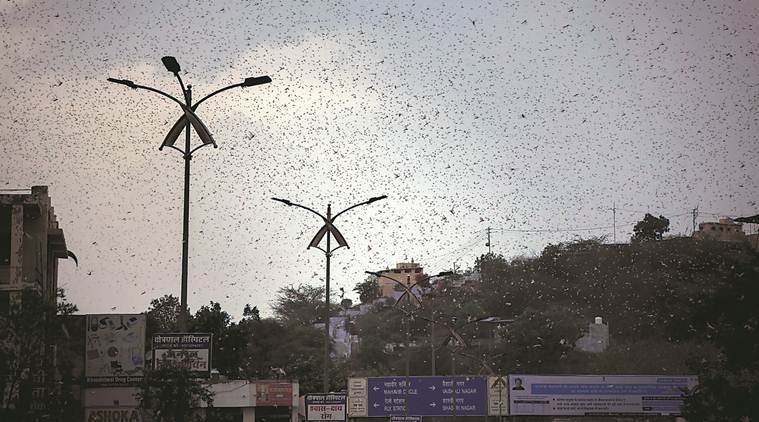 Several states and Union Territories, including Uttar Pradesh and Delhi, have warned against possible locust attacks. (PTI/File)
Several states and Union Territories, including Uttar Pradesh and Delhi, have warned against possible locust attacks. (PTI/File)
Acrid means pungent or bitter, and locusts leave a bitter taste in the mouth. I mean metaphorically, because of the devastation they cause. I have no idea what a locust tastes like. Acrida is a genus of grasshoppers. Following Carl Linnaeus, all living organism have Latin names. But acrid and acrida have different etymological roots — via Latin, acrida owes its origin to Greek and means locust. That’s the sense in which it is used (in Greek) in the Bible (Matthew 3.4, Mark 1.6), where there is a reference to eating locusts and wild honey. Indeed, locusts are efficient sources of food, far more than meat, but obviously not when swarms have been sprayed with harmful chemicals.
There was a Famine Inquiry Commission (Woodhead Commission) in 1945 which said, “as an instance of the possibility of the control of a pest over a vast area, the effective control of the desert locust, during its present cycle, may be mentioned…This warfare against the locust has been conducted by such simple means as trenching and poison-baiting.” Naturally, we have better means now. That Woodhead Commission led to the establishment of Directorate of Plant Protection Quarantine and Storage (in 1946). This subsumed the former Locust Warning Organisation, established in 1939.
As should be obvious, there are different types of locusts. The indigenous Bombay Locust is hardly of concern now. It has been relatively benign since 1908 (there was a minor swarm in 1927). Our concern, and that of several countries, is the Desert Locust, during its swarming phase. A smallish swarm is an outbreak. When an outbreak is upscaled, it becomes an upsurge. When an upsurge is upscaled further, it becomes a plague. We had the last plague in 1959-62 and the last upsurge in 1997. Severity depends on the number of swarms. For instance, the 1997 upsurge had only four swarms. The 1968 upsurge had 167 swarms and the 1993 upsurge had 172 swarms.
The Food and Agriculture Organisation (FAO) has a Desert Locust bulletin and our Directorate also has a locust bulletin. From neither could I make out how many swarms we have now. It’s a premature question. In a non-flying stage, locusts are hoppers. When hoppers move together, they are known as a group. When adults move together, they are known as a band. The bands become larger and become swarms. At any one point in time, we have individual hoppers, individual adults, groups, bands and swarms. Hence, we don’t know how many swarms there will be eventually. But as of now, we don’t have a plague. We do have an upsurge.
The Directorate administers statutes like the Destructive Insects and Pests Act (1914), its 1992 amendment, and the Insecticides Act (1968), neither of which is specific to locusts. For locusts specifically, one should look towards the East Punjab Agricultural Pests, Diseases and Noxious Weeds Act (1949), which is also applicable in Delhi. When the Centre for Civil Society identified Delhi laws for repeal, this figured in the list, but has not been repealed. Section 4(1)(2) of this statute mentions locusts, a section inserted in 1951: “Notwithstanding anything contained in this Act, in the event of any area being invaded, or in danger of an invasion, by locusts, the Collector of the district or other officer authorised by him in this behalf may call upon any male person not below the age of 14 years resident in the district to render all possible assistance in carrying out preventive or remedial measures and in the destruction of locusts…It shall not be necessary to notify every person individually for his services, and a proclamation by beat of drum or other customary modes in the village or locality shall be deemed sufficient notice to all affected persons residing in that village or locality.” Imagine COVID-19 information being disseminated through the beating of drums rather than Aarogya Setu.
The Punjab (as it then was) Legislative Assembly proceedings from 1951 explain why that amendment was introduced in 1951 (initially through an ordinance). In January 1951, Hissar, Gurgaon, Karnal, Ambala and Ludhiana were visited by locusts, with them eventually settling down in Hoshiarpur. Other than the government and the army, students and zamindars were also roped in to fight locusts and this was formalised through that ordinance/amendment. Like this year, locusts travelled beyond the immediately vulnerable areas in Rajasthan. Often, a statute cannot be repealed in entirety, since some sections remain relevant. For instance, in recent years, Punjab may not have invoked Section 4(1)(2) to fight locusts, but has used other sections to control parthenium. Other states have similar legislation — Assam, Andhra, Telangana, Tamil Nadu. However, there is a difference. In those cases, legislation doesn’t define an “insect pest” in the body of the legislation but leaves it to the notification. That’s the problem with the East Punjab legislation — its unnecessary specificity, where locusts and beating of drums are codified. The difference between a statute and rules/orders/notifications isn’t understood, a mindset that is the bane of other legislation too. A statute is passed by the legislature, rules/orders/notifications are in the executive’s domain, with information given to the legislature. Anything built into legislation also has to be formally repealed — a time-consuming process. Consequently, an anachronism like Section 4(1)(2) remains.
In 2020, farmers have beaten drums and utensils, used DJ-s and burst firecrackers to ward off locusts — in Rajasthan, Gujarat, Punjab, Maharashtra, Madhya Pradesh and Uttar Pradesh. But that’s not the same as disseminating information about locust invasions through the beating of drums. I haven’t found any instance of Section 4(1)(2) being invoked after 1951. The ordinance should have lapsed.
The writer is chairman, Economic Advisory Council to the PM. Views are personal.